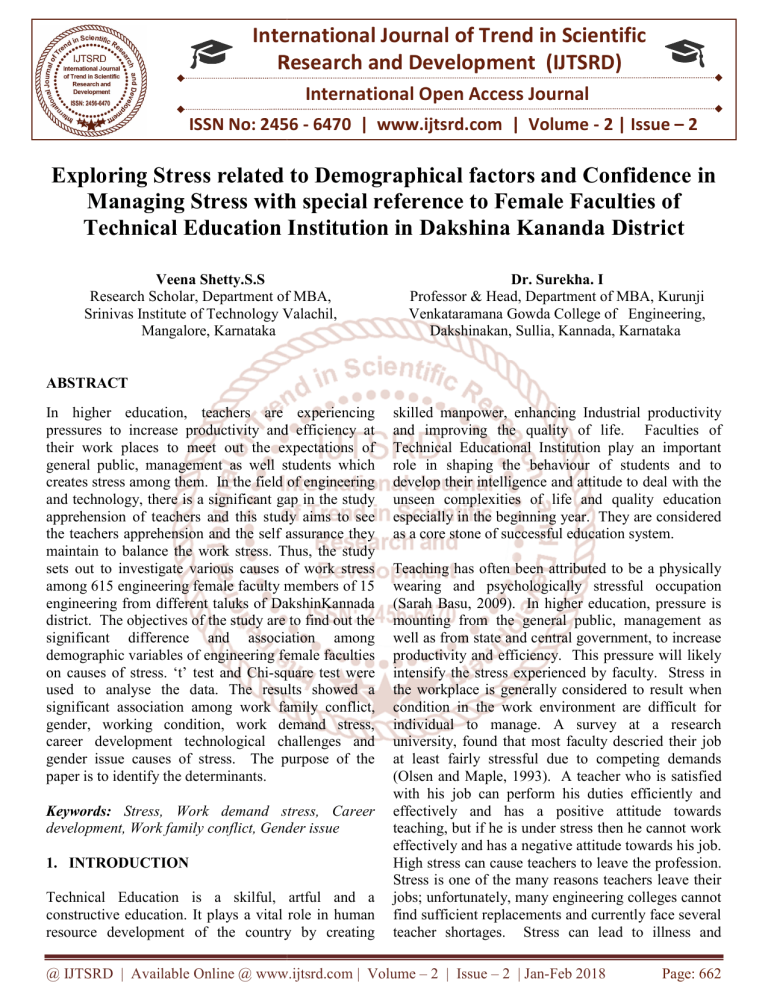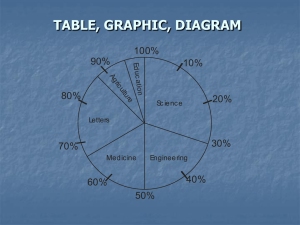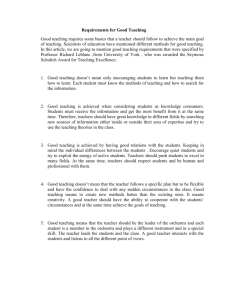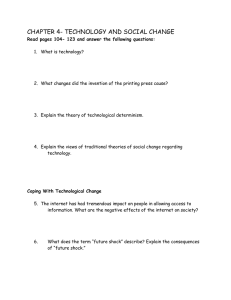
International Journal of Trend in Scientific
Research and Development (IJTSRD)
International Open Access Journal
ISSN No: 2456 - 6470 | www.ijtsrd.com | Volume - 2 | Issue – 2
Exploring Stress related to Demograp
Demographical
hical factors and Confidence in
Managing Stress with special rreference
eference to Female Faculties of
Technical Education Institution in Dakshina Kananda District
Veena Shetty.S.S
Research Scholar, Department of MBA,
Srinivas Institute of Technology Valachil,
Mangalore, Karnataka
Dr. Surekha. I
Professor & Head, Department of MBA, Kurunji
Venkataramana Gowda College of Engineering,
Dakshinakan, Sullia, Kannada, Karnataka
ABSTRACT
In higher education, teachers are experiencing
pressures to increase productivity and efficiency at
their work places to meet out the expectations of
general public, management as well students which
creates stress among them. In the field of engineering
and technology, there is a significant gap in the study
apprehension of teachers and this study aims to see
the teachers apprehension and the self assurance they
maintain to balance
ance the work stress. Thus, the study
sets out to investigate various causes of work stress
among 615 engineering female faculty members of 15
engineering from different taluks of DakshinKannada
district. The objectives of the study are to find out the
significant
gnificant difference and association among
demographic variables of engineering female faculties
on causes of stress. ‘t’ test and Chi-square
square test were
used to analyse the data. The results showed a
significant association among work family conflict,
gender,
r, working condition, work demand stress,
career development technological challenges and
gender issue causes of stress. The purpose of the
paper is to identify the determinants.
Keywords: Stress, Work demand stress, Career
development, Work family conflict, Gender issue
1. INTRODUCTION
Technical Education is a skilful, artful and a
constructive education. It plays a vital role in human
resource development of the country by creating
skilled manpower, enhancing Industrial productivity
and improving the
he quality of life. Faculties of
Technical Educational Institution play an important
role in shaping the behaviour of students and to
develop their intelligence and attitude to deal with the
unseen complexities of life and quality education
especially in the beginning year. They are considered
as a core stone of successful education system.
Teaching has often been attributed to be a physically
wearing and psychologically stressful occupation
(Sarah Basu, 2009). In higher education, pressure is
mounting from the general public, management as
well as from state and central government, to increase
productivity and efficiency. This pressure will likely
intensify the stress experienced by faculty. Stress in
the workplace is generally considered to result when
w
condition in the work environment are difficult for
individual to manage. A survey at a research
university, found that most faculty descried their job
at least fairly stressful due to competing demands
(Olsen and Maple, 1993). A teacher who is satisfied
satisf
with his job can perform his duties efficiently and
effectively and has a positive attitude towards
teaching, but if he is under stress then he cannot work
effectively and has a negative attitude towards his job.
High stress can cause teachers to leave the profession.
Stress is one of the many reasons teachers leave their
jobs; unfortunately, many engineering colleges cannot
find sufficient replacements and currently face several
teacher shortages. Stress can lead to illness and
@ IJTSRD | Available Online @ www.ijtsrd.com | Volume – 2 | Issue – 2 | Jan-Feb
Feb 2018
Page: 662
International Journal of Trend in Scientific Research and Development (IJTSRD) ISSN: 2456-6470
absenteeism. When a qualified educator is absent
from the classroom, student achievement is negatively
affected (Woods and Montagno, 1997). Teacher
stress is significantly correlated with the total number
of days that teachers are away from college (Zoe and
Denise, 1999). At present, the teacher is not satisfied
with his job due to changing job conditions, insecurity
of job, poor salary, biasness in promotions, work
overload, role conflict, powerlessness, motiveless,
harassment etc. (Geetha Nema et al. 2010).
1.2
Need and Significance of The Study
The study of stress management has assumed greater
significance in the context of emerging trends of
globalization and competitive environment. In India,
both Central and State government have approved for
high number of student’s enrolment in engineering
institutions in recent years. There is an increase in the
awareness among people for the need of higher
education, rising aspirations of the youth for better job
opportunities and most of the parents desire a secured
future for their children through better education.
The expectations of the students and their parents are
quiet high in private self-financing engineering
colleges and colleges having the autonomy status.
This in turn results in the demand for better
performance from the faculties in private colleges as
well.
Keeping the competition in view the
management demands good results from the faculty
members and also their workload is much more than
the faculty members of the other government colleges.
This Creates stress which leads to reduced faculty
efficiency. Given the paucity of research that
investigated the work stress in engineering education
related to demographical variables, and confidence of
faculties to deal with various type of stress related to
work family conflict, work condition, work demand,
work relation, career development, technological
challenges and gender issue
The findings of the
study may be immensely useful for faculties, students
Community and the public in general. It may hold
benefit for institutions and faculties of engineering
college. Stress is one of the many reasons faculties are
leaving their jobs; unfortunately, many engineering
colleges cannot find sufficient replacements and
currently face several faculties’ shortages. Although
studies related to stress has been done with reference
to faculties working in primary school, higher
secondary school and arts colleges, self-sided colleges
and deemed universities whereas only very few
studies have been conducted in the areas of stress
among female faculties of engineering colleges.
Furthermore, the negative consequences of job stress
on the work of college teachers induce further
research on the stress among female engineering
teachers in order to focus on, how to stem the tide of
increasing stress among the faculties of higher
educational institutions.
The present study has been carried out to identify the
further reasons that are initially hidden to the previous
researchers. In order to understand the consequences
of stress and to be able to cope effectively, some of
the major causes of stress should be identified.
1. How far demographical variable of engineering
faculties differ significantly and associated with
causes of stress?
2. How far demographical factor is significantly
associated with the confidence in managing stress
Since faculties are one of the most important units in
the educational system, it becomes essential to study
the various aspects that influence them. or to reduce
their intensity so as to increase the holding power of
the profession. In the field of engineering and
technology, there is a significant gap in the study of
stress among the female teachers and this study aims
to fill the gaps by examining the sources of work
stress and the confidence to deal with the same. The
study will identify the main stressors and the
confidence to face the same. The study was limited to
teaching female fraternity of engineering colleges
only and the parameters for measuring the effects of
stress were subjective rather than objective.
Thus, the study sets out to investigate various causes
of work stress related to demographical variable and
the confidence to deal with the same, among female
faculty of 15engineering colleges coming under VTU
affiliation in DakshinaKannada district and various
coping strategies adopted by them to manage stress
1.3 STATEMENT OF THE PROBLEM
The study covers all factors that influence the Stress
Management. Hence the present study is conceived
under the title. “Technical Teachers Apprehensions
and self-assurance with specific reference to
Dakshin Kannada district”
1.4 Implications of the Study
The current study has provided an insight into the
challenges faced by female faculty in engineering
@ IJTSRD | Available Online @ www.ijtsrd.com | Volume – 2 | Issue – 2 | Jan-Feb 2018
Page: 663
International Journal of Trend in Scientific Research and Development (IJTSRD) ISSN: 2456-6470
colleges in Dakshina Kannada district. Using this
study, several other interesting factors that influence
the self-assurance female faculty in engineering
colleges can be identified. For instance, the impact of
low job satisfaction and high stress levels on the job
performance of faculties in engineering colleges in
technical educational institution can be studied.
Studies conducted on female faculties in engineering
faculty in India are limited. Therefore, similar studies
can be conducted using a larger sample size.
Conducting a study using a larger sample size would
enhance the reliability of the data, which can further
be used by the All India Council of Technical
Education to enhance the quality of engineering
education in India. If sample size is large, the results
can also be generalized.
The current study is an attempt to understand
technical teacher’s apprehension and self-assurance
and its impact on job performance. The data obtained
from the study can be used to develop training,
counselling and coaching model for faculty working
in engineering colleges. Training the faculty to
develop appropriate strategies to deal with stress and
job dissatisfaction would help enhance the quality of
teaching. Results provided in the current study can be
used to conduct a comparative study with faculty
belonging to other disciplines. This would help
understand the challenges exclusively faced by
engineering faculty. A comparative study will also
help to know whether the factors effecting coping
strategies employed by faculty vary with regard to the
discipline they teach.
2. Objectives
A systematic study of stress among women faculties
in engineering colleges in dakshinakannada district is
very much needed the present study is conducted with
the following objectives:
1. To identify the stress level based on various
demographical variables
2. To ascertain the significant association between the
stress level and the confidence in dealing with stress
among female engineering teachers with demographic
variables.
Hypotheses
H1: There is a significant relationship between
Demographic factor and deal with different stress
level
H2: There is a significant relationship between
demographical factor and self efficacy in dealing
stress
3. Research Methodology
3.1 Data
The data required for the study is primary in nature.
The primary data are collected through making
questionnaire. Pilot study was conducted with 50
faculty members who belong to engineering
discipline. Based on the feedbacks and discussions
with the academic experts, the questionnaire has been
restructured.
3.1.2. Period and area
The study was conducted during the academic year
2016-17. Dakshin kannada district was chosen for the
study because large number of engineering colleges
are functioning in the district.
3.1.3 Sample and tools employed
Female faculties working in 15 engineering colleges
who had experience of more than three years were
selected for the study. Totally 716 questionnaires
were distributed among the selected population using
convenient sampling method. Only 615 questionnaires
have been returned by the respondents. The collected
data were analysed using’s’ test, and Chi-square test
3.4 Limitations
Data being primary in nature, all sorts of limitations
applicable to primary data is applicable to the present
study also. This study is confined to Coimbatore
district so utmost care should be taken while
generalizing the result.
@ IJTSRD | Available Online @ www.ijtsrd.com | Volume – 2 | Issue – 2 | Jan-Feb 2018
Page: 664
International Journal of Trend in Scientific Research and Development (IJTSRD) ISSN: 2456-6470
4. Analysis and Interpretation
Table No.4.1: Descriptive Statistic for Stress Scores
Descriptive statistics of stress scores
Stressors
Total
Mean
Standard
Deviation
7.313
Mean
Percentage
45.71
Individual Stressor /Work family conflict 45
20.57
stress
Work Condition stress
35
18.25
6.081
52.14
Work demand Stress
50
24.45
8.368
48.90
Work relation Stress
35
17.20
6.646
49.14
Career development
25
12.81
4.862
51.24
Technological changes
25
11.99
5.553
47.96
Gender Issues
10
4.67
2.411
46.70
Source: primary data
Table 4.1 shows the descriptive statistics for the stress of 7 components each having a maximum score of 5,
level of the female faculties in Individual stressor and giving total maximum score 35, in which the mean is
organization level stress,
17.20 with a standard deviation of 6.646, the mean
Individual stressor /work family conflict consist of 9 percentage is 49.14. On average, the respondents
components each having a maximum score of 5, experienced moderate level of stress due to work
giving total maximum score of 45, in which the mean relation. Career development stress consists of 5
is 20.57 with a standard deviation of 7.313 and mean components each having a maximum score of 5,
percentage is 45.71. On average, the respondents giving total score 25, in which the mean is 12.81 with
experienced moderate level of stress due to a standard deviation of4.862, the mean percentage
work/family conflict. Organizational level stress 51.24. The respondents experienced moderate level of
consists work condition stress, work demand stress, stress due to Career development. Technology
work relation stress, stress on career development, challenges Stress consist of 5 components each
technological changes and gender issue. Work having a maximum score of 5, giving total maximum
condition stress consist of 7 components each having score 25, in which the mean is 11.19 with a standard
a maximum score of 5, giving total maximum score of deviation of 5.553, the mean percentage is 47.96. The
35, in which the mean is 18.25 with a standard mean stress due to Technology challenges is
deviation of 6.081, the mean percentage is 52.14. moderate, Gender Issue related Stress consist of 2
Thus, the respondents experienced moderate level of components each having a maximum score of 5,
stress due to work condition on average. Work giving total maximum score 10, in which the mean is
demand stress consist of 10 components each having a 4.67 with a standard deviation of 2.411, the mean
maximum score of 5, giving total maximum score 50, percentage 46.70. On average, the respondents
in which the mean is 24.45 with a standard deviation experienced moderate level of stress due to Gender
of 8.368, the mean percentage is 48.90.Based on issue.
average work demand lead to a moderate level of
stress in the respondents. Work relation Stress consist
Table No.4.2 Descriptive Statistic for Confidence Scores
Descriptive statistics of Confidence levels
Levels of Confidence
Total
Mean
Standard
Mean
Deviation
Percentage
In balancing Work - family roles
45
31.24
8.227
69.42
In facing Work Condition stress
35
26.15
5.753
74.71
In meeting Work- demand
50
37.74
9.049
75.48
In sustaining Work- relation
35
26.30
6.628
75.14
In assuring Career development
25
17.58
4.951
70.32
In responding to Technological changes
25
18.90
5.561
75.60
In tackling Gender Issues
10
7.31
2.604
73.10
@ IJTSRD | Available Online @ www.ijtsrd.com | Volume – 2 | Issue – 2 | Jan-Feb 2018
Page: 665
International Journal of Trend in Scientific Research and Development (IJTSRD) ISSN: 2456-6470
Source: primary data
Table 4.2 shows the descriptive statistics for the components each having a maximum score of 5,
confidence level of the female faculties in dealing giving total maximum score 35, in which the mean is
with Individual stressor and organization level stress. 26.30 with a standard deviation of 6.628, the mean
Individual stressor /work family conflict consist of 9 percentage 75. 14.On average, the respondents
components each having a maximum score of 5, experience high level of confidence in managing
giving total maximum score of 45, in which the mean stress due to Work relation. Career development
is 31.24 with a standard deviation of 8.227 and mean confidence consists of 5 components each having a
percentage is 69.42. On average, the respondents maximum score of 5, giving total score 25, in which
experience moderate level of confidence in managing the mean is 17.58 with a standard deviation of 4.951,
stress due to work/family conflict. Confidence in the mean percentage 70.32. On average, the
dealing with Organizational stress consists confidence respondents experience high level of confidence in
level in work condition, work demand, work relation, managing stress due to Career development.
career development, technological changes and Technology changes confidence consist of 5
gender issue. In Work condition confidence consist of components each having a maximum score of 5,
7 components each having a maximum score of 5, giving total maximum score 25, in which the mean is
giving total maximum score of 35, in which the mean 18.90 with a standard deviation of 5.561, the mean
is 26.15 with a standard deviation of 5.753, the mean percentage 75.60. On average, the respondents
percentage is 74.71. On average, the respondents experience high level of confidence in managing
experience high level of confidence in managing stress due to Technology changes. GenderIssuerelated
stress due to work condition.
Stress consist of 2 components each having a
Work demand confidence consist of 10 components maximum score of 5, giving total maximum score 10,
each having a maximum score of 5, giving total in which the mean is 7.31 with a standard deviation of
maximum score 50, in which the mean is 37.74 with a 2.604, the mean percentage73.10. On average, the
standard deviation of 9.0498, the mean percentage 75. respondents experience high level of confidence in
48.. On average, the respondents experience moderate managing stress due to Gender Issue.
level of confidence in managing stress due to work
demand. Work relation confidence consist of 7
Table. No 4.3:
Chi-square test results of association between Demographic factors and various stressors
Chi-square test results of association between Demographic factors and various stressors
Demographic
Various stressors
s
Work
Work
Career
Technological Gender
family
conditi Work
Working development
Challenges
Issues
roles
on
demand relation
7.699*
7.001
3.648
4.917
2.525
10.634*
8.110*
Age Group
Marital Statu
s
22.330**
.005
3.379
1.116
.741
5.835*
.162
Spouse
employment
2.769
1.435
4.549
1.267
14.576*
.833
6.402
Family Type
7.494**
.382
3.948*
3.069
.367
.012
.002
*Moderately Significant
**Highly Significant
Stress experienced due to Work family conflict varied
significantly higher at the level of (p=0.00) in the
variables Marital status (χ2 =22.330) and family type
(χ2 =7.494).And moderately significant in age
group(χ2=7.699). stress experienced due to Work
demand varied significantly with family type (χ2
=3.948,) Stress experienced due to career
development varied significantly higher at the level of
(p=0.00) in the variableSpouse employment(χ2
=14.576)technological challenges stress level is
@ IJTSRD | Available Online @ www.ijtsrd.com | Volume – 2 | Issue – 2 | Jan-Feb 2018
Page: 666
International Journal of Trend in Scientific Research and Development (IJTSRD) ISSN: 2456-6470
associated with various demographical
variables.
Stress experienced due to technological challenges
was significantly related with Age group (χ2 =10.634,
p=0.014) and Marital status (χ2 =5.835, p=0.016).The
above table shows how gender issue challenges stress
level is associated with various demographical
variables. Stress experienced due to gender issue
challenges varied significantly at the level of
(p=0.044) in the variables Age group (χ2 =8.110),
Table. No 4.3:Chi-square test results of association between Demographic factors and Confidence
Chi-square test results of association between Demographic factors and various Indicators of confidence
in handling stress
Demographics
Confidence in Handling stressors
Work
Work
Career
Technological
Gender
family condition
Work
Working
development
Challenges
Issues
roles
demand
relation
12.627
16.148*
3.024a
5.132
21.033**
17.863**
7.479
Age Group
**
.671
.765
8.777**
5.983*
4.830*
Marital Status 44.796
**
2.027
7.048
3.879
5.920
3.814
3.240
6.467
1.984
Spouse
employment
Family Type
.691
*Moderately Significant
.007
.756
.655
.437
2.798
1.197
**Highly Significant
In Table No:4.3 Confidence in dealing with work
family conflict varied significantly higher at the level
of (p=0.00) in the variables Age group (χ2 =12.627)
Marital status (χ2 =44.796).Confidence in dealing
with work condition stress varied significantly higher
at the level of (p=0.00) in the variables Age group (χ2
=16.148).Confidence in dealing with career
development stress varied significantly higher at the
level of (p=0.00) in the variables Age group (χ2
=21.003) Marital status (χ2 =8.777). Confidence in
dealing with technological challenges varied
significantly higher at the level of (p=0.00) in the
variables Age group (χ2 =17.863) and was moderate
in Marital status (χ2=5.983).Confidence in dealing
with gender issue stress varied significantly higher at
the level of (p=0.00) in the variables marital status (χ2
=4.830)
Findings
In descriptive statistics for stress score ,on an average
respondents experience moderate level of stress due to
work family conflict, work condition stress ,work
relation
stress,
carreer
development
stress
,technological challenges and gender issue
.In
descriptive statistics for confidence score Confidence
in work family conflict ,work demand was moderate
were as confidence was high in managing work
condition stress, work relation stress, career
development ,technological challenges and gender
issue. When it comes to test results of association
between Demographic factors and various stressors
and confidence to deal with the same .Married
faculties are experiencing high work family conflict
stress. Faculties staying in joint family are facing high
work family conflict stress (N=209). Confidence in
dealing with work family conflict varied significantly
higher at the level of (p=0.00) in the variables Age
group (χ2 =12.627) Marital status (χ2 =44.796).
Confidence in dealing with work condition stress
varied significantly higher at the level of (p=0.00) in
the variables Age group (χ2 =16.148).. Stress
experienced due to career development varied
significantly higher at the level of in the variable
Spouse employment. Confidence in dealing with
career development stress varied significantly higher
at the level of in the variables Agegroup Marital status
.Stress experienced due to technological challenges
was significantly related with Agegroup and Marital
status .There was no significant relationship of
technological challenges stress with spouse
employment and family type . Confidence in dealing
with technological challenges varied significantly
higher at the level of (p=0.00) in the variables
@ IJTSRD | Available Online @ www.ijtsrd.com | Volume – 2 | Issue – 2 | Jan-Feb 2018
Page: 667
International Journal of Trend in Scientific Research and Development (IJTSRD) ISSN: 2456-6470
Agegroup (χ2 =17.863).The above table shows how
gender issue challenges stress level is associated with
various demographical variables. Stress experienced
due to gender issue challenges varied significantly at
the level of (p=0.044) in the variables Age group(χ2
=8.110)
5. Conclusion
The study identifies that the female faculties working
in technical educational institution have high stress
.The variable such as work family conflict, working
condition, work demand ,work relation, career
development ,technological challenges and gender
issue had high level of significance associated with
the stress level and the confidence in managing the
stress .Further ,the result reveals that demographical
factor plays a significant role I balancing the stress
level and managing it in a confident manner .and
improving the job performance by adopting coping
strategies to manage stress
References
1. Abouserie, R. (1996). Stress, Coping Strategies
and Job Satisfaction in
University Academic
Staff: An International Journal of Experimental
Educational Psychology,16, pp 49-56.
2. Ackers.(1989). Teachers, Gender and Careers. The
Falmer Press, New York. 1989.
3. Aditi, N; and Kumari, B.( 2005). Impact of
personality patterns and employment status
On psychological stress tolerance of women in
Kerala. Indian Psy.Rev, 64(2), 103- 108.
4. Abrol, K.K., (1990). A study of Language Strain
and
Coping
behaviours
of
Teachers,
Psycholingua, 20:173-178.
5. Albrecht K. (1979). Stress and the Manager:
Making it Work for You:NewYork,Simon&
Schuster
6. Aldana SG, Sutton LD, Jacobson BH, Quirk MG.,
(1996). Relationships between Leisure time
physical activity and perceived stress. Department
of Physical Education: Brigham Young University,
Provo, UT
7. Anita Devi, S.( 2007). Occupational stress: A
comparative study of women indifferent
occupations: Prajnan, 35(1):61-74.
8. Burke, R. J., &Richardson, A. M. (1996). Stress,
burnout, and health. In C. Cooper (Ed.),
Handbook of stress, medicine, and health (pp.101117). Boca Raton, FL: CRC Press.
9. Christopher Gilbers., (2003), "Reviews Evidence
Normalizing Breathing Patterns" All India
Institute of Medical Science, New Delhi.
10. Charles Kowalski (2002). Caring for Teachers in
Uncaring Schools. Curriculum Innovation, Testing
and Evaluation: Proceedings of the 1st Annual
JALT Pan-SIG
11. Crandall, R. &Perrewe, L. P., (2005).
Occupational Stress: A Handbook. New York:
Taylor & Francis.
12. Dey, E.L., Ramirez, C.E., Korn, W.S., and Astin,
A. W. (1993). The American College Teacher:
National Norms for the 1992-93 HERI Faculty
Survey, Los Angeles: Higher Education Research
Institute.
13. Dewe, P. (1986). An investigation into the causes
and consequences of teacher stress. New Zealand
Journal of Educational Studies, 21 (2), pp 145157.
14. Doune, M. (1999). Teacher Attrition: A Review of
Literature. Teaching and Teacher Education, 15,
pp 835-848.
15. Drudy,S.(1989). Gender balance/gender bias: the
teaching profession and the impact of
feminization. Gender and Education. Vol 20, No
4, pp. 309– 323.
16. Fried, M. R., (2008). Stress Management for
Success in the Workplace: London, Oxford
University Press.
17. Gandham, S. R., (2000).The Safety and Health
Practioner :Borehamwood, 18(1), 20.
18. Gaurav
Bhargava,
NeelamSaraswat
and
Aakanksha Singh (2010). Stress and Stress
Management in Recession: Pacific Business
Review International, pp 47-58.
19. Geetha
Nema,
Dhanashree
Nagar,
YogitaMandhanya (2010). A Study on the Causes
of Work Related Stress among the College
Teachers, Pacific Business Review International,
pp 1-7.
20. Gmelch, W. H. (1993).Coping with Faculty
Stress. New York: Sage Publications.
21. Gmelch, W. H. (1984). Educators’ responses to
stress: Towards a coping taxonomy. Paper
presented at the Annual Meeting of the American
Educational Research Association: New Orleans,
LA.
22. Gmelch, W. H., Lovrich, N. P., and Wilke, P. K.,
(1984). Stress in Academe: A National
Perspective. Research in Higher Education, 20(4),
pp 477-490.
@ IJTSRD | Available Online @ www.ijtsrd.com | Volume – 2 | Issue – 2 | Jan-Feb 2018
Page: 668
International Journal of Trend in Scientific Research and Development (IJTSRD) ISSN: 2456-6470
23. Griffith, J., Steptoe, A., and Cropley, M. (1999).
An Investigation of Coping Strategies Associated
with Job Stress in Teachers: British Journal of
Educational Psychology, 69 (4), pp 517-531.
24. Hardie Boys, N. (1996), Workload and Stress: a
report of ASTE members. Wellington: New
Zealand Council for Educational research and
Association of Staff in Tertiary Education.
25. Hardy,Sally(1998),Occupational Stress; Personal
and
Professional
Approaches
:United
Kingdom,Stanleyhornes Ltd,pp.18-45
26. Haynes, S. G., &Feinleib, M. (1980). Women,
work, and coronary heart disease: Prospective
findings from the Framingham Heart Study.
American Journal of Public Health,
70, 133141.
27. Hicks, T. & Caroline, M., (2007). A Guide to
Managing Workplace Stress: California Universal
Publishers.
28. Hodson R &ChamerliainL.J.(2003).Sources of
reduced Job stress Organizational Coherence,
local
Ownership
and
Workers
Involvement:Psycholingua,pp.173-178
29. Hui, E. K. P. & Chan, D. W. (1996). Teacher
Stress and Guidance Work in Hong Kong
Secondary School Teachers: British Journal of
Guidance and Counselling, 24, pp 199-211.
30. Kinnunen; SMauno,S.(1998).Antecedents and
outcomes of work-family conflict among
employed women and men in Finland. Human
Relations: Journal of Occupational Health
Psychology Vol51,Pp. 157–177
31. Kinman, G. (2001). Pressure points: A review of
research on Stressors and Strains in UK
Academics: Educational Psychology, 21, pp 473492.
32. Krohne, H.W. (2001). Stress and Coping
Theories: The International Encyclopedia of the
Social and Behavioural Sciences:Johannes
Gutenberg-University Main Seattle.
33. Kyriacou, C.(1987). Teacher Stress and Burnout:
An
International
Review.
Educational
Research,53(1).
34. Long, B. C. (2006). Aerobic Conditioning and
Stress Inoculation: A Comparison of Stress
Management Interventions. Cognitive Therapy
and Research, 8, 517-542.
35. Manthei, R. and Solman, R. (1988).Teacher stress
and negative outcomes in Canterbury state
schools: New Zealand Journal of Educational
Studies, 23, pp 145- 163.
36. Monat, A. & Lazarus, S. R., (2001). Stress and
Coping: An Anthology. Columbia: Columbia
University Press
37. Mujtaba and McCartney, (2007).Research over
the situations begins stress: New Book,
Publication,New Delhi. The Icfaian Journal
management , Vol VII No-12 Dec 2008
38. Nolan, M. (2009). Top Ten Sources of Workplace
Stress and How to Fight Them. Retrieved from
people metrics.
39. Naik,S.P.(2008) .Education for the twenty first
century. New Delhi: Anmol publications.
40. Olsen, D. (1993). Work Satisfaction and Stress in
the first and their year of Academic Appointment.
Journal of Higher Education, 64, pp 453-471.
41. Olsen, D. and Maple, S. A. (1993), Gender
Differences among Faculty at a Research
University: Myths and Realities. Initiatives, 55(4),
pp 33-42.
42. Reddy and Poornima, (2012).Role Stress and
Coping among Business School Professors:
43. A Phenomenological Study IBS Hyderabad IFHE
University, Donthanapalli, Hyderabad, Telangana,
India
44. Repetti, R. L., Matthews, K. A., & Waldron, I.
(1989). Employment and women’s health: Effects
of paid employment on women’s mental and
physical health. American Psychologist, 44, 13941401.
45. Richard, G.V. and Krieshok, T.S. (1989),
Occupational Stress, Strain, and Coping in
University Faculty: Journal of Vocational
Behaviour, 34, pp 117-132. Sarah Basu (2009),
Stress among Teacher Educators:University News,
47(49).
46. Schultz and Schultz (2010),Psychology and work
today:Newyork:Prentice Hall.p.374
47. Shonfeld, I. S. (2001), Stress in 1st-year Women
Teachers: The Context of Social Support and
Coping. Genetic Social and General Psychology
Monographs, 127, pp 133-168.
48. Senthil Kumar ,A;Mohan, S; Velmurugan
,R.(2013) Causes of Work Stress of Teachers in
Engineering Education: ASIAN JOURNAL OF
MANAGEMENT RESEARCH Volume 3 Issue 2,
418
49. Smith, E., Anderson, J.L. and Lovrich, N.P.
(1995). The Multiple Sources of Workplace Stress
among Land-Grant University Faculty. Research
in Higher Education, 36, pp 261-282
50. Smith, E, & Witt, S. L. (1993). A Comparative
Study of Occupational Stress among African
@ IJTSRD | Available Online @ www.ijtsrd.com | Volume – 2 | Issue – 2 | Jan-Feb 2018
Page: 669
International Journal of Trend in Scientific Research and Development (IJTSRD) ISSN: 2456-6470
American and White University Faculty: A
Research Note. Research in Higher Education, 34,
pp 229-241.
51. Stephen P. Robbins and Timothy A. Judge,
(2007), Organizational Behavior:Pearson/Prentice
Hall.
52. Sultana, A.M(2013).Constraints faced by Working
and Non-working Women in their
Families:
Australian Journal of Basic and Applied Sciences,
Vol7, No 6, Pp. 719-722. 2013.
53. Susan
Gill,
Marilyn
J
Davidson.,
(2001).Organizational Job Satisfaction University
of Florida
54. Woods, R. C., &Montagno, R. V. (1997).
Determining the Negative Effect of Teacher
Attendance on Student Achievement. Education,
118(2), pp 307-316.
55. Vieet, V. S., (2011). Stress: Coping Mechanisms
in the Workplace. Retrieved from <
http://voices.yahoo.com/stress-copingmechanisms-workplace
56. Zoe Ann Brown and Denise L. Uehara (1999).
Coping with Teacher Stress: A Research Synthesis
for Pacific Educators. Pacific Resources of
Education and Learning, ED 440 924, pp 1-22.
@ IJTSRD | Available Online @ www.ijtsrd.com | Volume – 2 | Issue – 2 | Jan-Feb 2018
Page: 670




